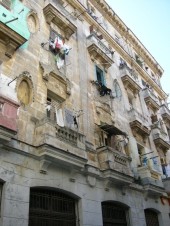Impressions of Cuba, pt. 1- life in a time warp by Marjorie Arons-Barron
The entry below is being cross posted from Marjorie Arons-Barron’s own blog. Check it out.
 As Sun Country’s flight 8830 touched down in Havana the morning of February 25th, the flight attendant announced, “Ladies and Gentlemen. Welcome to Havana.” A cheer went up, people clapped, and some eyes misted over. It was an inexplicably emotional moment, but it speaks to the fact that Cuba and the United States, just a 49-minute flight separating them, absolutely should have normal relations. And not just because the temperature in Havana was 100 degrees warmer than the minus 13 degrees left behind in Boston.
As Sun Country’s flight 8830 touched down in Havana the morning of February 25th, the flight attendant announced, “Ladies and Gentlemen. Welcome to Havana.” A cheer went up, people clapped, and some eyes misted over. It was an inexplicably emotional moment, but it speaks to the fact that Cuba and the United States, just a 49-minute flight separating them, absolutely should have normal relations. And not just because the temperature in Havana was 100 degrees warmer than the minus 13 degrees left behind in Boston.
Cuba is of a different era, or a combination of eras. Colonized by Spain in the 15th century, which wiped out its indigenous population, it was a hub of shipping and trading routes. The British occupied it in 1762. The Spanish got it back a scant year later, and for more than a century built European architecture and colonial institutions. In the mid 19th century, Cuba became just the fifth country in the world to build a railroad. The project drew indentured workers from China and Ireland and slaves from Africa.
In 1898, the United States entered the Spanish-American War (viewed by Cubans as a war of independence) only to exploit Cuba economically, especially for its sugar and tobacco. By the 1940’s and ’50’s, Cuba under Fulgencio Battista, who stole mercilessly from his own people, was effectively run by the Mafia. Cuba’s many efforts to achieve true independence succeeded only briefly in 1959 when Fidel Castro threw out the corrupt overlords, driving out Battista, burning the contents of the casinos. But he turned it into a Communist state, driving out the landowners and business people and becoming dependent on the Soviet Union. With the collapse of the Soviet Union in the 1990’s and the disappearance of financial supports, Cuba was on its own to survive economically, and the people of Cuba, who were never prosperous, have suffered mightily ever since.
photo Jim Barron
The poverty is dramatic, in the hemisphere second only to Haiti. And it is a country in disrepair. Neoclassical and baroque buildings lining the main streets of its cities bespeak eras of bygone elegance but are badly in need of restoration. Paint is peeling; stucco is stained and crumbling; shutters are broken. Mansions have been subdivided. Where once a single family lived, ten families now do, each with six or seven members. Laundry hangs out to dry in most of the once lovely balconies. New Soviet-style apartment buildings also sprung up and have deteriorated. Of the entire housing stock, most are about 75 years old, and an average of three buildings are said to collapse every day.
 The poverty and lack of economic development are even more visible outside Havana, where men still till the soil by pulling plows and harvest sugar cane using machetes, sometimes aided by ancient combines. Many go to work in horse-drawn carts with ladders and tool boxes on the backs. In towns we visited, for the most part even tiny darkened homes had their porches swept clean, with relatively little litter in their yards.
The poverty and lack of economic development are even more visible outside Havana, where men still till the soil by pulling plows and harvest sugar cane using machetes, sometimes aided by ancient combines. Many go to work in horse-drawn carts with ladders and tool boxes on the backs. In towns we visited, for the most part even tiny darkened homes had their porches swept clean, with relatively little litter in their yards.
In 1959, the Castro government cut rents in half and committed to eliminating eviction and homelessness, but there are still waiting lists to get into housing. A person may buy a home, without, of course, any “market” setting the price. People have 20 years to pay, and there is no mortgage, no interest. So now some 94 percent of housing stock is in private hands, but people own their own units without owning the building.
According to a Havana University professor and architect with whom we met, the result is that no one in Havana takes responsibility for the common areas of their buildings, which feeds the disrepair. With an average monthly salary equivalent to $20, a gallon of paint costs 30 percent of one’s salary. A new toilet costs 444 percent of that salary. Where you do see a freshly painted building, it’s likely to come from remittances, gifts of money sent from families abroad.
So life is a struggle, but the people are proud, friendly and, in the wake of recent talks about normalizing US/Cuba relations, seem now to have a sense of optimism. The fact that some restoration is under way, that some private enterprise is getting traction, that the health and education systems are highly developed and that arts and culture are important to the government and the people, all combine to provide a foundation for a Cuba on the move, however glacial that forward momentum might be.
I welcome your comments in the section below.
